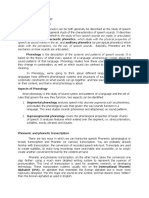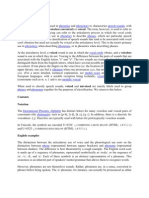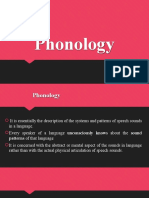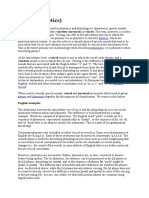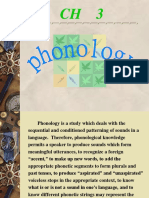0 ratings0% found this document useful (0 votes)
4short Notes
4short Notes
Uploaded by
rody.rodina36Copyright:
© All Rights Reserved
Available Formats
Download as DOCX, PDF, TXT or read online from Scribd
Download as docx, pdf, or txt
4short Notes
4short Notes
Uploaded by
rody.rodina360 ratings0% found this document useful (0 votes)
Copyright
© © All Rights Reserved
Available Formats
DOCX, PDF, TXT or read online from Scribd
Share this document
Did you find this document useful?
Is this content inappropriate?
Copyright:
© All Rights Reserved
Available Formats
Download as DOCX, PDF, TXT or read online from Scribd
Download as docx, pdf, or txt
0 ratings0% found this document useful (0 votes)
4short Notes
4short Notes
Uploaded by
rody.rodina36Copyright:
© All Rights Reserved
Available Formats
Download as DOCX, PDF, TXT or read online from Scribd
Download as docx, pdf, or txt
You are on page 1/ 4
What is a Phoneme?
The phoneme is defined as the smallest distinctive, or contrastive in
the sound system of a language. A single phoneme can distinguish the
word cab from the word cap, serve from surf and seal from zeal.
Phonemes are usually written in slashes // to distinguish them from
phones [ ]. It is the mental representation of a specific word. This
means it is the mental image we store in our brains of the specific
word and is associated with the sound of the word.
What is Allophone?
An allophone is the different ways you can say a word or basically
another way to pronounce a phoneme. For example, [pʰ] as in pin
and [p] as in spin are allophones for the phoneme /p/ because they
cannot distinguish words (in fact, they occur in complementary
distribution). English-speakers treat them as the same sound, but they
are different: the first is aspirated and the second is unaspirated
(plain).This variation can also be seen in the various ways different
speakers of the English language pronounce ‘water.’
An American English speaker will pronounce water with a “d” instead
of “t” like other English speakers. These different ways in which a
word can be pronounced are then called an Allophone.
The differences between allophones and phonemes.
A phoneme is a set of allophones or individual non-contrastive speech
segments. Allophones are sounds, whilst a phoneme is a set of such
sounds. Allophones are usually relatively similar sounds which are in
mutually exclusive or complementary distribution. Allophones are
different ways to pronounce the same phoneme while keeping the
same. meaning. Allophones are phonetic variations - different
pronunciations - of the same phoneme. Using a different allophone
does not change meaning. The /l/ sound is pronounced differently in
'love' and in 'wool'.
Transcribing phones
When we describe phones, we use narrow transcription (to include
as many aspects of a specific pronunciation as possible) and place the
letters and symbols between two square brackets ( [ ] ). Phonetic
(narrow) transcriptions give us lots of information about how to
physically produce sounds.
For example, the word 'port' has an audible exhalation of air after the
letter 'p'. This is shown in the phonetic transcription with a [ʰ] and the
word port in phonetic transcript would look like this [pʰɔˑt].
Let's take a look at some more examples of phonetic transcription.
Head - [ˈhɛd]
Shoulders- [ˈʃəʊldəz]
Knees - [ˈniːz]
And - [ˈənd]
Toes - [ˈtəʊz]
Transcribing phonemes
When describing phonemes, we use broad transcription (only
mentioning the most notable and necessary sounds) and place the
letters and symbols between two slashes ( / / ). For example, the
English word apple would look like this /æpəl/.
Here are some further examples of phonemic transcriptions
Head - / hɛd /
Shoulders - / ˈʃəʊldəz /
Knees - / niːz /
And - / ənd /
Toes - / təʊz /
As you can see, both transcriptions are very similar, as they follow the
IPA. However, look closely, and you will see some diacritics in the
phonetic transcriptions that do not appear in the phonemic
transcriptions. These diacritics provide a few more details about
how to pronounce the actual sounds.
2.Stressed and unstressed syllables vs. strong and weak syllables
the prominence of a sound can be attributed mainly to a combination of loudness, pitch,
duration, and sound quality. Just as there are more prominent and less prominent sounds
within a syllable (the most prominent being the syllable centre), there are more prominent
and less prominent syllables within a (polysyllabic) word. Furthermore , the four features -
loudness, pitch, duration, and sound quality - are also the main components of stress.
Prominence in the perception of speech, then, results from stress in its production, and we
therefore speak of stressed syllable and an unstressed syllable. While stressed syllables can
contain any vowel (monophthong or diphthong) except /ə/.unstressed syllables contain
mainly /ə/. /ɪ/. /ʊ/ and (in order of frequency) as in agree /əgri:/. regard /rɪga:d/.and
neigbbourhood /neɪbəhʊd/.
less commonly,other vowels such as/ʌ/in unsafe /ʌnseɪf/and /əu/ in obese /əubi:s/ and also
the syllabic consonants [l̩. n̩. m̩. r̩. ŋ} because they are vowels from a phonological point of
view.
And while the vowels in stressed syllables always have their ‘full’original sound qualIty. it can
be demonstrated that most /ə/ and /ɪ/ phonemes in unstressed syllables result From a
reduction, or weakening, of such full vowels owing to a shift in stress. For example, the /æ/
in land /lænd/ remains an /æ/ in landing /lændın/ bécause it occurs in a stressed syllable.
but it is reduced to /ə/ in England /ɪnglənd/ because here it occurs in an unstressed syllable.
Similarly. the /e/ in the noun present /preznt/ is reduced to /ɪ/ in the verb present /prɪzent/
because the shift in word class is accompanied, or rather brought about, by a shift in stress,
from the first syllable to the second. (Sometimes the reduced vowels in unstressed syllables
cannot be clearly identified as either /ə/ or /ɪ/ And the choice between the two symbols is
then largely arbitrary.) But there are of course also cases where the vowels in unstressed
syllables retain their original sound quality. The /a:/ in art /ɑːt/, for example, remains an /a:/
in artistic /a:tıstik/ although in the latter word it occurs in an unstressed syllable, and the /u:/
in stupid /stju:pıd/ remains an /u:/ in stupidity /stju:pıdətı/.
English sylablle structure
Languages have specific ways of combining sounds to form words or parts of words, known
as syllables. These syllables are a group of one or more sounds, with the essential part being a
vowel sound (V) which may be preceded or followed by a consonant (C) or a cluster of
consonants (CC or CCC). In English, a syllable can consist of a vowel preceded by one
consonant (CV), two consonants (CCV), three consonants (CCCV), or follwed by one
consonant (VC), two consonants (VCC), three consonants (CVCCC), or four consonants
(CVCCCC) as in texts/teksts/. Analyzing these restrictions and regularities helps us
understand the syllable structure of a language.
Syllables are a peak of sonority, surrounded by less sonorous sounds. Sonority is acoustic
energy, and the most sonorous sounds are vowels produced with an unobstructed vocal tract.
Consonants, on the other hand, have obstructions in the vocal tract, making them less
sonorous. Our mental grammar organizes words into syllables and structures what is inside
them. The most sonorous part of a syllable is the nucleus, which is typically a vowel produced
with an unobstructed vocal tract. The nucleus and coda form a unit called the rhyme, and
linguists use the Greek letter sigma (σ) to label the entire syllable. Sonority is described by the
degree of airflow obstruction and voicing that occurs during phonation.
The onset is the initial phonological unit of a word, while the "rime" refers to the string of
letters following it, usually a vowel and final consonants. Not all words have onsets. A word
is monosyllabic if it has one syllable. The nucleus is the most sonorous part, with the vowel
being the nucleus. Some words have an onset but no coda, while others have a coda but not an
onset. Some words have neither an onset nor a coda, just a nucleus.
You might also like
- English Phonetics and Phonology - Doc NOTES80% (5)English Phonetics and Phonology - Doc NOTES49 pages
- Mechanotechnology N3: Lecturer: MT Mphago Maluti Tvet College100% (1)Mechanotechnology N3: Lecturer: MT Mphago Maluti Tvet College11 pages
- Particle Physics Mind Map by Saad (Edexcel) PDF50% (2)Particle Physics Mind Map by Saad (Edexcel) PDF1 page
- Practical Phonetics and Phonology. Part 2.No ratings yetPractical Phonetics and Phonology. Part 2.15 pages
- English and Arabic Phonemes and AllophonesNo ratings yetEnglish and Arabic Phonemes and Allophones3 pages
- English Phonological and Graphological System100% (1)English Phonological and Graphological System10 pages
- Nama: Muhammad Irwan Phonology NIM: 17111024210002No ratings yetNama: Muhammad Irwan Phonology NIM: 171110242100025 pages
- LU4_Phonology_4Nov2024_e46cc2c14f4e44d3427c5d5e253c1833No ratings yetLU4_Phonology_4Nov2024_e46cc2c14f4e44d3427c5d5e253c183354 pages
- Syllable, Word Stress, WV, Neutralized Vowels, ElisionNo ratings yetSyllable, Word Stress, WV, Neutralized Vowels, Elision29 pages
- 2 notatki linguistics phonetics and phonology 2No ratings yet2 notatki linguistics phonetics and phonology 29 pages
- Week 1: Mythology and Folklore English Class Professor: John Michael CulturaNo ratings yetWeek 1: Mythology and Folklore English Class Professor: John Michael Cultura7 pages
- Phonology: The Sound Patterns of Language: Thomas Carlyle (1795-1881) A High School StudentNo ratings yetPhonology: The Sound Patterns of Language: Thomas Carlyle (1795-1881) A High School Student57 pages
- The Production and Representation of Speech SoundsNo ratings yetThe Production and Representation of Speech Sounds3 pages
- Weakstrong Syllables 1225480882591451 9No ratings yetWeakstrong Syllables 1225480882591451 931 pages
- Stress and Vowel Reduction in English - WikipediaNo ratings yetStress and Vowel Reduction in English - Wikipedia15 pages
- Webster's American English Dictionary (with pronunciation guides): With over 50,000 references (US English)From EverandWebster's American English Dictionary (with pronunciation guides): With over 50,000 references (US English)Alice Grandison5/5 (1)
- Midterm Solutions Phys 255 Sfu Simon Fraser UniversityNo ratings yetMidterm Solutions Phys 255 Sfu Simon Fraser University9 pages
- 5b. Mixed Exam-Style Questions On Exponentials and Logarithms - AnswersNo ratings yet5b. Mixed Exam-Style Questions On Exponentials and Logarithms - Answers2 pages
- Build Your Own Conferencing System With ASP - NET MVC - Part 1No ratings yetBuild Your Own Conferencing System With ASP - NET MVC - Part 16 pages
- 13 Secondary Storage Devices: Let's ThinkNo ratings yet13 Secondary Storage Devices: Let's Think4 pages
- 1919 - Hoxton - The Joule Thompson Effect For Air at Moderate Temperatures and Pressures PDFNo ratings yet1919 - Hoxton - The Joule Thompson Effect For Air at Moderate Temperatures and Pressures PDF42 pages
- Standard Specifications Geotechnical Design Manual: Walls and Buried StructuresNo ratings yetStandard Specifications Geotechnical Design Manual: Walls and Buried Structures10 pages
- A Chemistry Project On: Study of Constituents of AlloyNo ratings yetA Chemistry Project On: Study of Constituents of Alloy17 pages
- Oracle Database 21c Enterprise Edition Release 21No ratings yetOracle Database 21c Enterprise Edition Release 2125 pages
- FOOT-05000001 Hallux System 2.8 Product InformationNo ratings yetFOOT-05000001 Hallux System 2.8 Product Information32 pages
- Mcat Questions Chemistry - Chemical Equilibrium.0.No ratings yetMcat Questions Chemistry - Chemical Equilibrium.0.2 pages
- Influence of Washer Size and Tightening Torque On The Strength of Bolted Joints in (0/ 45/90) S Gfre CompositesNo ratings yetInfluence of Washer Size and Tightening Torque On The Strength of Bolted Joints in (0/ 45/90) S Gfre Composites12 pages
- Negative Mass: by Robert Nemiroff Michigan TechNo ratings yetNegative Mass: by Robert Nemiroff Michigan Tech11 pages
- Mechanotechnology N3: Lecturer: MT Mphago Maluti Tvet CollegeMechanotechnology N3: Lecturer: MT Mphago Maluti Tvet College
- Nama: Muhammad Irwan Phonology NIM: 17111024210002Nama: Muhammad Irwan Phonology NIM: 17111024210002
- LU4_Phonology_4Nov2024_e46cc2c14f4e44d3427c5d5e253c1833LU4_Phonology_4Nov2024_e46cc2c14f4e44d3427c5d5e253c1833
- Syllable, Word Stress, WV, Neutralized Vowels, ElisionSyllable, Word Stress, WV, Neutralized Vowels, Elision
- Week 1: Mythology and Folklore English Class Professor: John Michael CulturaWeek 1: Mythology and Folklore English Class Professor: John Michael Cultura
- Phonology: The Sound Patterns of Language: Thomas Carlyle (1795-1881) A High School StudentPhonology: The Sound Patterns of Language: Thomas Carlyle (1795-1881) A High School Student
- The Production and Representation of Speech SoundsThe Production and Representation of Speech Sounds
- The Pronunciation of English: A Reference and Practice BookFrom EverandThe Pronunciation of English: A Reference and Practice Book
- Webster's American English Dictionary (with pronunciation guides): With over 50,000 references (US English)From EverandWebster's American English Dictionary (with pronunciation guides): With over 50,000 references (US English)
- Midterm Solutions Phys 255 Sfu Simon Fraser UniversityMidterm Solutions Phys 255 Sfu Simon Fraser University
- 5b. Mixed Exam-Style Questions On Exponentials and Logarithms - Answers5b. Mixed Exam-Style Questions On Exponentials and Logarithms - Answers
- Build Your Own Conferencing System With ASP - NET MVC - Part 1Build Your Own Conferencing System With ASP - NET MVC - Part 1
- 1919 - Hoxton - The Joule Thompson Effect For Air at Moderate Temperatures and Pressures PDF1919 - Hoxton - The Joule Thompson Effect For Air at Moderate Temperatures and Pressures PDF
- Standard Specifications Geotechnical Design Manual: Walls and Buried StructuresStandard Specifications Geotechnical Design Manual: Walls and Buried Structures
- A Chemistry Project On: Study of Constituents of AlloyA Chemistry Project On: Study of Constituents of Alloy
- FOOT-05000001 Hallux System 2.8 Product InformationFOOT-05000001 Hallux System 2.8 Product Information
- Mcat Questions Chemistry - Chemical Equilibrium.0.Mcat Questions Chemistry - Chemical Equilibrium.0.
- Influence of Washer Size and Tightening Torque On The Strength of Bolted Joints in (0/ 45/90) S Gfre CompositesInfluence of Washer Size and Tightening Torque On The Strength of Bolted Joints in (0/ 45/90) S Gfre Composites







